Dispersion of Few-Layer Black Phosphorus in Binary Polymer Blend and Block Copolymer Matrices
Abstract
:1. Introduction
2. Materials and Methods
2.1. Materials
2.2. Preparation of PS/PMMA/fl-bP Composites by Solution Blending
2.2.1. bP Exfoliation
2.2.2. Preparation of PS/PMMA/fl-bP Composites
2.3. Preparation of PMMA-b-PS/fl-bP Composite via In Situ RAFT Polymerization
2.4. Characterization
3. Results
3.1. PS/PMMA/fl-bP Composites by Solution Blending
3.2. PMMA-b-PS/fl-bP Composite via In Situ RAFT Polymerization
4. Conclusions
Supplementary Materials
Author Contributions
Funding
Data Availability Statement
Acknowledgments
Conflicts of Interest
References
- Gusmão, R.; Sofer, Z.; Pumera, M. Black phosphorus rediscovered: From bulk material to monolayers. Angew. Chem. Int. Ed. 2017, 56, 8052–8072. [Google Scholar] [CrossRef]
- Peruzzini, M.; Bini, R.; Bolognesi, M.; Caporali, M.; Ceppatelli, M.; Cicogna, F.; Coiai, S.; Heun, S.; Ienco, A.; Benito, I.I.; et al. A perspective on recent advances in phosphorene functionalization and its applications in devices. Eur. J. Inorg. Chem. 2019, 2019, 1476–1494. [Google Scholar] [CrossRef]
- Eswaraiah, V.; Zeng, Q.; Long, Y.; Liu, Z. Black phosphorous nanosheets: Synthesis, characterization and applications. Small 2016, 12, 3480–3502. [Google Scholar] [CrossRef] [PubMed]
- Dhanabalan, S.C.; Ponraj, J.S.; Guo, Z.; Li, S.; Bao, Q.; Zhang, H. Emerging trends in phosphorene fabrication towards next generation devices. Adv. Sci. 2017, 4, 1600305. [Google Scholar] [CrossRef]
- Kou, L.; Chen, C.; Smith, S.C. Phosphorene: Fabrication, properties, and applications. J. Phys. Chem. Lett. 2015, 6, 2794–2805. [Google Scholar] [CrossRef] [PubMed]
- Ren, X.; Lian, P.; Xie, D.; Yang, Y.; Mei, Y.; Huang, X.; Wang, Z.; Yin, X. Properties, preparation and application of black phosphorous/phosphorene for energy storage: A review. J. Mater. Sci. 2017, 52, 10364–10386. [Google Scholar] [CrossRef]
- Pang, J.; Bachmatiuk, A.; Yin, Y.; Trzebicka, B.; Zhao, L.; Fu, L.; Mendes, R.G.; Gemming, T.; Liu, Z.; Rummeli, M.H. Applications of phosphorene and black phosphorus in energy conversion and storage devices. Adv. Energy Mater. 2017, 8, 1702093. [Google Scholar] [CrossRef]
- Castellanos-Gomez, A.; Vicarelli, L.; Prada, E.; Island, J.O.; Narasimha-Acharya, K.L.; Blanter, S.I.; Groenendijk, D.J.; Buscema, M.; Steele, G.A.; Alvarez, J.V. Isolation and characterization of few-layer black phosphorus. 2D Mater. 2014, 1, 025001. [Google Scholar] [CrossRef]
- Woomer, A.H.; Farnsworth, T.W.; Hu, J.; Wells, R.A.; Donley, C.L.; Warren, S.C. Phosphorene: Synthesis, scale-up, and quantitative, optical spectroscopy. ACS Nano 2015, 9, 8869–8884. [Google Scholar] [CrossRef] [PubMed]
- Qiu, M.; Ren, W.X.; Jeong, T.; Won, M.; Park, G.Y.; Sang, D.K.; Liu, L.; Zhang, H.; Kim, J.S. Omnipotent phosphorene: A next-generation, two-dimensional nanoplatform for multidisciplinary biomedical applications. Chem. Soc. Rev. 2018, 47, 5588–5601. [Google Scholar] [CrossRef]
- Li, Q.; Wu, J.T.; Liu, Y.; Qi, X.M.; Jin, H.G.; Yang, C.; Liu, J.; Li, G.L.; He, Q.G. Recent advances in black phosphorus-based electrochemical sensors: A review. Anal. Chim. Acta 2021, 1170, 338480. [Google Scholar] [CrossRef]
- Zhu, Y.; Xie, Z.; Li, J.; Liu, Y.; Li, C.; Liang, W.; Huang, W.; Kang, J.; Cheng, F.; Kang, L.; et al. From phosphorus to phosphorene: Applications in disease theranostics. Coord. Chem. Rev. 2021, 446, 214110. [Google Scholar] [CrossRef]
- Sui, Y.; Zhou, J.; Wang, X.; Wu, L.; Zhong, S.; Li, Y. Recent advances in black-phosphorus-based materials for electrochemical energy storage. Mater. Today 2021, 42, 117–136. [Google Scholar] [CrossRef]
- Shen, Z.K.; Yuan, Y.J.; Pei, L.; Yu, Z.T.; Zou, Z. Black phosphorus photocatalysts for photocatalytic H2 generation: A review. Chem. Eng. J. 2020, 386, 123997. [Google Scholar] [CrossRef]
- Sakthivel, T.; Huang, X.; Wu, Y.; Rtimi, S. Recent progress in black phosphorus nanostructures as environmental photocatalysts. Chem. Eng. J. 2020, 379, 122297. [Google Scholar] [CrossRef]
- Pica, M.; D’Amato, R. Chemistry of Phosphorene: Synthesis, Functionalization and Biomedical Applications in an Update Review. Inorganics 2020, 8, 29. [Google Scholar] [CrossRef]
- Tran, V.; Soklaski, R.; Liang, Y.; Yang, L. Layer-controlled band gap and anisotropic excitons in few-layer black phosphorus. Phys. Rev. B 2014, 89, 235319. [Google Scholar] [CrossRef]
- Khandelwal, A.; Mani, K.; Karigerasi, M.H.; Lahiri, I. Phosphorene—The two-dimensional black phosphorous: Properties, synthesis and applications. Mater. Sci. Eng. B 2017, 221, 17–34. [Google Scholar] [CrossRef]
- Guo, Z.; Zhang, H.; Lu, S.; Wang, Z.; Tang, S.; Shao, J.; Sun, Z.; Xie, H.; Wang, H.; Yu, X.-F.; et al. From black phosphorus to phosphorene: Basic solvent exfoliation, evolution of Raman scattering, and applications to ultrafast photonics. Adv. Funct. Mater. 2015, 25, 6996–7002. [Google Scholar] [CrossRef]
- Yasaei, P.; Kumar, B.; Foroozan, T.; Wang, C.; Asadi, M.; Tuschel, D.; Indacochea, J.E.; Klie, R.F.; Salehi-Khojin, A. High-quality black phosphorus atomic layers by liquid-phase exfoliation. Adv. Mater. 2015, 27, 1887–1892. [Google Scholar] [CrossRef]
- Late, D.J. Liquid exfoliation of black phosphorus nanosheets and its application as humidity sensor. Microporous Mesoporous Mater. 2016, 225, 494–503. [Google Scholar] [CrossRef]
- Kuriakose, S.; Ahmed, T.; Balendhran, S.; Bansal, V.; Sriram, S.; Bhaskaran, M.; Walia, S. Black phosphorus: Ambient degradation and strategies for protection. 2D Mater. 2018, 5, 032001. [Google Scholar] [CrossRef]
- Li, Q.; Zhou, Q.; Shi, L.; Chen, Q.; Wang, J. Recent advances in oxidation and degradation mechanisms of ultrathin 2D materials under ambient conditions and their passivation strategies. J. Mater. Chem. A 2019, 7, 4291–4312. [Google Scholar] [CrossRef]
- Coiai, S.; Passaglia, E.; Pucci, A.; Ruggeri, G. Nanocomposites based on thermoplastic polymers and functional nanofiller for sensor applications. Materials 2015, 8, 3377–3427. [Google Scholar] [CrossRef]
- Del Río Castillo, E.; Reyes-Vazquez, C.D.; Rojas-Martinez, L.E.; Thorat, S.B.; Serri, M.; Martinez-Hernandez, A.L.; Velasco-Santos, C.; Pellegrini, V.; Bonaccorso, F. Single-step exfoliation and functionalization of few-layers black phosphorus and its application for polymer composites. Flat. Chem. 2019, 18, 100131. [Google Scholar] [CrossRef]
- Ni, H.; Liu, X.; Cheng, Q. A new strategy for air-stable black phosphorus reinforced PVA nanocomposites. J. Mater. Chem. A 2018, 6, 7142–7147. [Google Scholar] [CrossRef]
- Tiouitchi, G.; Raji, M.; Mounkachi, O.; Ali, M.A.; Mahmoud, A.; Boschini, F.; Essabir, H.; Bouhfid, R.; Qaiss, A. Black phosphorus-based polyvinylidene fluoride nanocomposites: Synthesis, processing and characterization. Comp. Part B Eng. 2019, 175, 107165. [Google Scholar] [CrossRef]
- Qiu, S.; Zou, B.; Sheng, H.; Guo, W.; Wang, J.; Zhao, Y.; Wang, W.; Yuen, R.K.; Kan, Y.; Hu, Y. Electrochemically exfoliated functionalized black phosphorene and its polyurethane acrylate nanocomposites: Synthesis and applications. ACS Appl. Mater. Interfaces 2019, 11, 13652–13664. [Google Scholar] [CrossRef]
- Ren, X.; Mei, Y.; Lian, P.; Xie, D.; Yang, Y.; Wang, Y.; Wang, Z. A novel application of phosphorene as a flame retardant. Polymers 2018, 10, 227. [Google Scholar] [CrossRef] [PubMed]
- He, L.; Zhou, X.; Cai, W.; Xiao, Y.; Chu, F.; Mu, X.; Fu, X.; Hu, Y.; Song, L. Electrochemical exfoliation and functionalization of black phosphorene to enhance mechanical properties and flame retardancy of waterborne polyurethane. Compos. B Eng. 2020, 202, 108446. [Google Scholar] [CrossRef]
- Yin, S.; Ren, X.; Lian, P.; Zhu, Y.; Mei, Y. Synergistic effects of black phosphorus/boron nitride nanosheets on enhancing the flame-retardant properties of waterborne polyurethane and its flame-retardant mechanism. Polymers 2020, 12, 1487. [Google Scholar] [CrossRef] [PubMed]
- Cai, W.; Wang, B.B.; Wang, X.; Zhu, Y.L.; Li, Z.X.; Xu, Z.M.; Song, L.; Hu, W.Z.; Hu, Y. Recent Progress in Two-dimensional Nanomaterials Following Graphene for Improving Fire Safety of Polymer (Nano) composites. Chin. J. Polym. Sci. 2021, 39, 935–956. [Google Scholar] [CrossRef]
- Li, C.; Cui, X.; Gao, X.; Liu, S.; Sun, Q.; Lian, H.; Zu, L.; Liu, Y.; Wang, X.; Cui, X. Electrochemically prepared black phosphorene micro-powder as flame retardant for epoxy resin. Compos. Interfaces 2021, 28, 693–705. [Google Scholar] [CrossRef]
- Qu, Z.; Wu, K.; Jiao, E.; Chen, W.; Hu, Z.; Xu, C.; Sci, J.; Wang, S.; Tan, Z. Surface functionalization of few-layer black phosphorene and its flame retardancy in epoxy resin. Chem. Eng. J. 2020, 382, 122991. [Google Scholar] [CrossRef]
- Qu, Z.; Wu, K.; Meng, W.; Nan, B.; Hu, Z.; Xu, C.A.; Tan, Z.; Zhang, Q.; Meng, H.; Shi, J. Surface coordination of black phosphorene for excellent stability, flame retardancy and thermal conductivity in epoxy resin. Chem. Eng. J. 2020, 397, 125416. [Google Scholar] [CrossRef]
- Qu, Z.; Xu, C.A.; Hu, Z.; Li, Y.; Meng, H.; Tan, Z.; Shi, J.; Wu, K. (CF3SO3)3Er-decorated black phosphorene for robust ambient stability and excellent flame retardancy in epoxy resin. Compos. B Eng. 2020, 202, 108440. [Google Scholar] [CrossRef]
- Zou, B.; Qiu, S.; Ren, X.; Zhou, Y.; Zhou, F.; Xu, Z.; Zhao, Z.; Song, L.; Hu, Y.; Gong, X. Combination of black phosphorus nanosheets and MCNTs via phosphoruscarbon bonds for reducing the flammability of air stable epoxy resin nanocomposites. J. Hazard. Mater. 2020, 383, 121069. [Google Scholar] [CrossRef]
- Passaglia, E.; Cicogna, F.; Lorenzetti, G.; Legnaioli, S.; Caporali, M.; Serrano-Ruiz, M.; Ienco, A.; Peruzzini, M. Novel polystyrene-based nanocomposites by phosphorene dispersion. RSC Adv. 2016, 6, 53777–53783. [Google Scholar] [CrossRef]
- Passaglia, E.; Cicogna, F.; Costantino, F.; Coiai, S.; Legnaioli, S.; Lorenzetti, G.; Borsacchi, S.; Geppi, M.; Telesio, F.; Heun, S.; et al. Polymer-based black phosphorus (bP) hybrid materials by polymerization in situ: A suitable tool to exfoliate bP and stabilize bP nanoflakes. Chem. Mater. 2018, 30, 2036–2048. [Google Scholar] [CrossRef] [PubMed]
- Telesio, F.; Passaglia, E.; Cicogna, F.; Costantino, F.; Serrano-Ruiz, M.; Peruzzini, M.; Heun, S. Hybrid nanocomposites of 2D black phosphorus nanosheets encapsulated in PMMA polymer material: New platforms for advanced device fabrication. Nanotechnology 2018, 29, 295601. [Google Scholar] [CrossRef]
- Zhang, H.; Zuo, M.; Zhu, W.; Zhao, A.; Shi, X.; Zhang, X.; Song, Y.; Zheng, Q. Control of selective location of homopolymer-brush grafted nanoparticles in binary polymer blends. Comp. Sci. Technol. 2020, 200, 108439. [Google Scholar] [CrossRef]
- Sarkar, B.; Alexandridis, P. Block copolymer–nanoparticle composites: Structure, functional properties, and processing. Prog. Polym. Sci. 2015, 40, 33. [Google Scholar] [CrossRef]
- Gelfer, M.Y.; Hyun, H.S.; Liu, L.; Benjamin, S.H.; Benjamin, C.; Rafailovich, M.; Mayu, S.; Vladimir, Z. Effects of organoclays on morphology and thermal and rheological properties of polystyrene and poly(methyl methacrylate) blends. J. Polym. Sci. Part B 2003, 41, 44. [Google Scholar] [CrossRef]
- Mao, C.; Zhu, Y.T.; Jiang, W. Design of electrical conductive composites: Tuning the morphology to improve the electrical properties of graphene filled immiscible polymer blends. ACS Appl. Mater. Interfaces 2012, 4, 5281–5286. [Google Scholar] [CrossRef] [PubMed]
- Bai, L.; He, S.; Fruehwirth, J.W.; Stein, A.; Macosko, C.W.; Cheng, X. Localizing graphene at the interface of cocontinuous polymer blends: Morphology, rheology, and conductivity of cocontinuous conductive polymer composites. J. Rheol. 2017, 61, 575–587. [Google Scholar] [CrossRef]
- Bockstaller, M.R.; Mickiewicz, R.A.; Thomas, E.L. Block copolymer nanocomposites: Perspectives for tailored functional materials. Adv. Mater. 2005, 17, 1331–1349. [Google Scholar] [CrossRef]
- Hasegawa, N.; Usuki, A. Arranged Microdomain Structure Induced by Clay Silicate Layers in Block Copolymer-Clay Nanocomposites. Polym. Bull. 2003, 51, 77–83. [Google Scholar] [CrossRef]
- Köpf, M.; Eckstein, N.; Pfister, D.; Grotz, C.; Krüger, I.; Greiwe, M.; Hansen, T.; Kohlmann, H.; Nilges, T. Access and in situ growth of phosphorene-precursor black phosphorus. J. Cryst. Growth 2014, 405, 6–10. [Google Scholar] [CrossRef]
- Jana, S.; Parthiban, A.; Chai, C.L.L. Narrow disperse polymers using amine functionalized dithiobenzoate RAFT agent and easy removal of thiocarbonyl end group from the resultant polymers. J. Polym. Sci. 2011, 49, 1494. [Google Scholar] [CrossRef]
- Hanlon, D.; Backes, C.; Doherty, E.; Cucinotta, C.S.; Berner, N.C.; Boland, C.; Lee, K.; Harvey, A.; Lynch, P.; Gholamvand, Z.; et al. Liquid exfoliation of solvent-stabilized few-layer black phosphorus for applications beyond electronics. Nat. Commun. 2015, 6, 8563. [Google Scholar] [CrossRef]
- Lee, J.K.; Han, C.D. Evolution of a dispersed morphology from a co-continuous morphology in immiscible polymer blends. Polymer 1999, 40, 2521–2536. [Google Scholar] [CrossRef]
- Liscio, A.; Kouroupis-Agalou, K.; Diez Betriu, X.; Kovtun, A.; Treossi, E.; Pugno, N.M.; De Luca, G.; Giorgini, L.; Palermo, V. Evolution of the size and shape of 2D nanosheets during ultrasonic fragmentation. 2D Mater. 2017, 4, 025017. [Google Scholar] [CrossRef]
- Egerton, R.F.; Li, P.; Malac, M. Radiation damage in the TEM and SEM. Micron 2004, 35, 399–409. [Google Scholar] [CrossRef]
- Caporali, M.; Serrano-Ruiz, M.; Telesio, F.; Heun, S.; Verdini, A.; Cossaro, A.; Dal Miglio, M.; Goldoni, A.; Peruzzini, M. Enhanced ambient stability of exfoliated black phosphorus by passivation with nickel nanoparticles. Nanotechnology 2020, 31, 275708. [Google Scholar] [CrossRef] [PubMed]
- Rohini, R.; Bose, S. Electromagnetic interference shielding materials derived from gelation of multiwall carbon nanotubes in polystyrene/poly(methyl methacrylate) blends. ACS Appl. Mater. Interfaces 2014, 6, 11302–11310. [Google Scholar] [CrossRef] [PubMed]
- Harirchian-Saei, S.; Wang, M.C.P.; Gates, B.D.; Moffitt, M.G. Directed polystyrene/poly (methyl methacrylate) phase separation and nanoparticle ordering on transparent chemically patterned substrates. Langmuir 2012, 28, 10838–10848. [Google Scholar] [CrossRef]
- Dekeyser, C.M.; Biltresse, S.; Marchand-Brynaert, J.; Rouxhet, P.G.; Dupont-Gillain, C.C. Submicrometer-scale heterogeneous surfaces by PS-PMMA demixing. Polymer 2004, 45, 2211–2219. [Google Scholar] [CrossRef]
- Ton-That, C.; Shard, A.G.; Daley, R.; Bradley, R.H. Effects of annealing on the surface composition and morphology of PS/PMMA blend. Macromolecules 2000, 33, 8453–8459. [Google Scholar] [CrossRef]
- Malwela, T.; Ray, S.S. Study of morphology and crystal growth behaviour of nanoclay-containing biodegradable polymer blend thin films using atomic force microscopy. Polymer 2012, 53, 2705–2716. [Google Scholar] [CrossRef]
- Kashiwagi, T.; Inaba, A.; Brown, J.E.; Hatada, K.; Kitayama, T.; Masuda, E. Effects of weak linkages on the thermal and oxidative degradation of poly(methyl methacrylates). Macromolecules 1986, 19, 2160–2168. [Google Scholar] [CrossRef]
- Zhang, Z.; Xin, X.; Yan, Q.; Li, Q.; Yang, Y.; Ren, T.-L. Two-step heating synthesis of sub-3 millimeter-sized orthorhombic black phosphorus single crystal by chemical vapor transport reaction method. Sci. China Mater. 2016, 59, 122–134. [Google Scholar] [CrossRef]
- Liu, C.; Wu, W.; Shi, Y.; Yang, F.; Liu, M.; Chen, Z.; Yu, B.; Feng, Y. Creating MXene/reduced graphene oxide hybrid towards highly fire safe thermoplastic polyurethane nanocomposites. Comp. B Eng. 2020, 203, 108486. [Google Scholar] [CrossRef]
- Shi, Y.; Liu, C.; Duan, Z.; Yu, B.; Liu, M.; Song, P. Interface engineering of MXene towards super-tough and strong polymer nanocomposites with high ductility and excellent fire safety. Chem. Eng. J. 2020, 399, 125829. [Google Scholar] [CrossRef]
- Shi, Y.; Liu, C.; Liu, L.; Fu, L.; Yu, B.; Lv, Y.; Yang, F.; Song, P. Strengthening, toughing and thermally stable ultra-thin MXene nanosheets/polypropylene nanocomposites via nanoconfinement. Chem. Eng. J. 2019, 378, 122267. [Google Scholar] [CrossRef]
- Barton, D.H.R.; Vonder Embse, R.A. The invention of Radical reactions. Part 39. The Reaction of White Phosphorus with Carbon-Centered Radicals. An Improved procedure for the Synthesis of Phosphonic Acids and Further Mechanistic Insights. Tetrahedron 1998, 54, 12475–12496. [Google Scholar] [CrossRef]
- Barton, D.H.R.; Zhu, J. Elemental White Phosphorus as a Radical Trap: A New and General Route to Phosphonic Acids. J. Am. Chem. Soc. 1993, 115, 2071–2072. [Google Scholar] [CrossRef]
- Antonatos, N.; Bouša, D.; Kovalska, E.; Sedmidubský, D.; Růžička, K.; Vrbka, P.; Veselý, M.; Hejtmánek, J.; Sofer, Z. Large-scale production of nanocrystalline black phosphorus ceramics. ACS Appl. Mater. Interfaces 2020, 12, 7381–7391. [Google Scholar] [CrossRef]

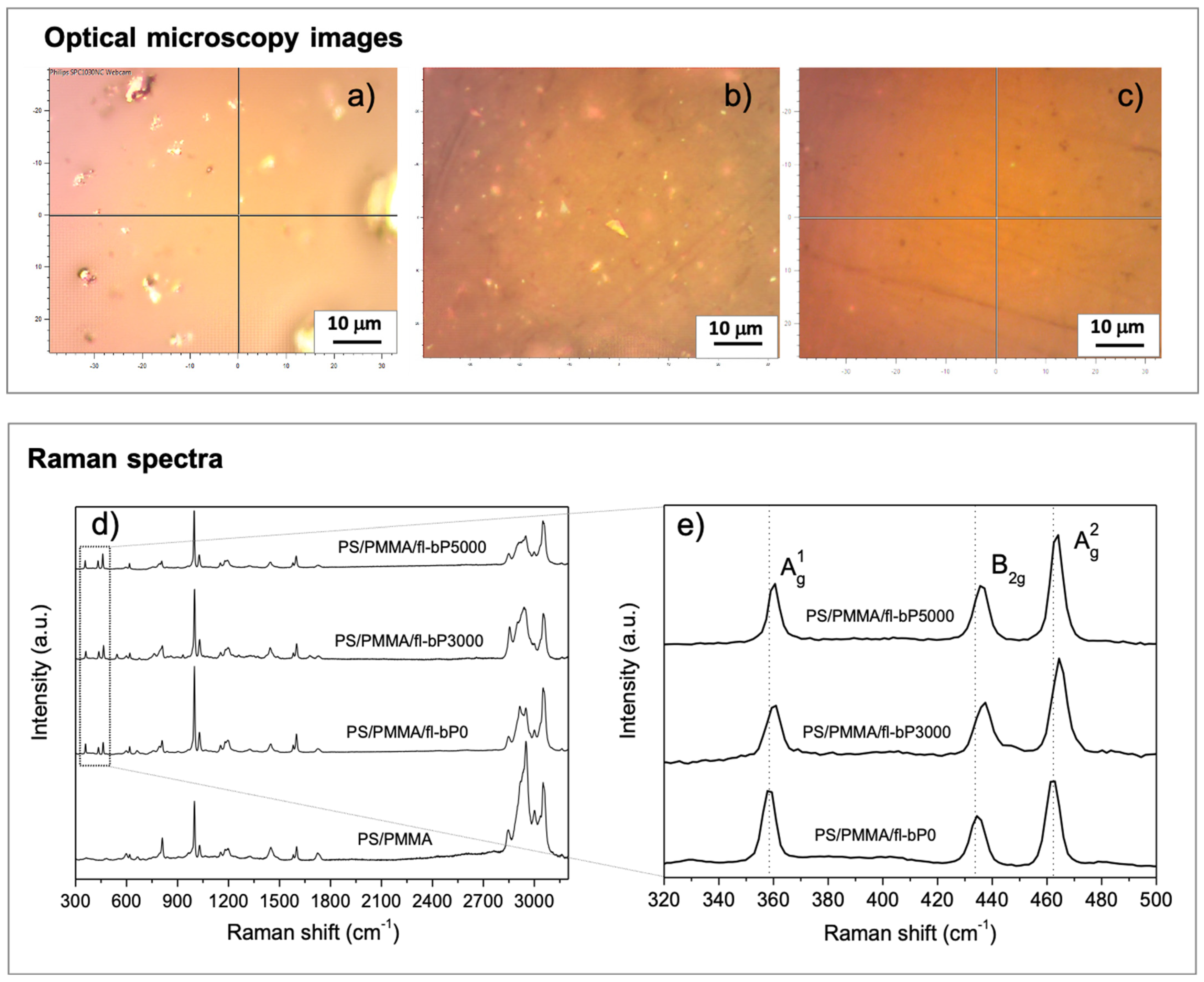
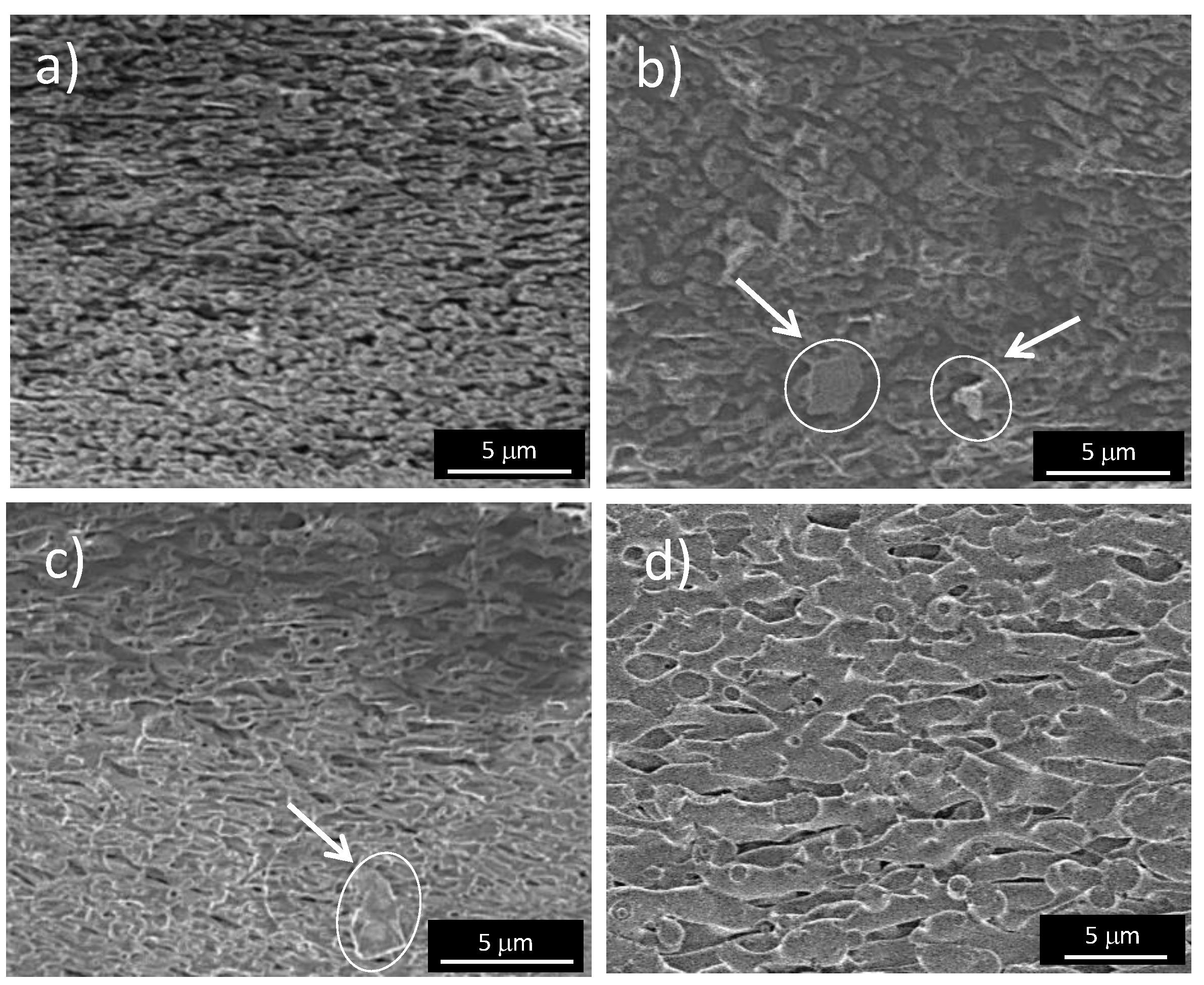
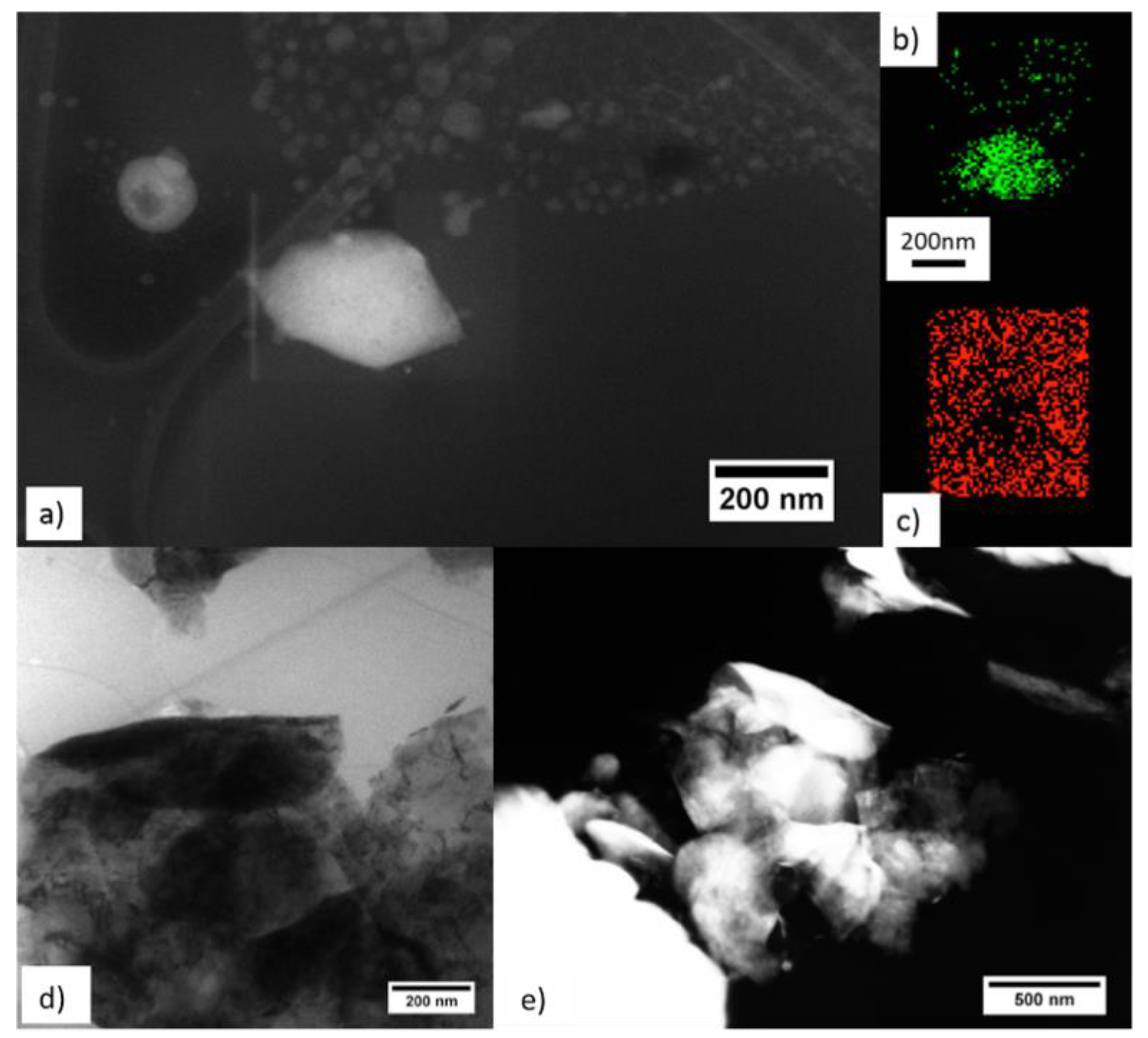
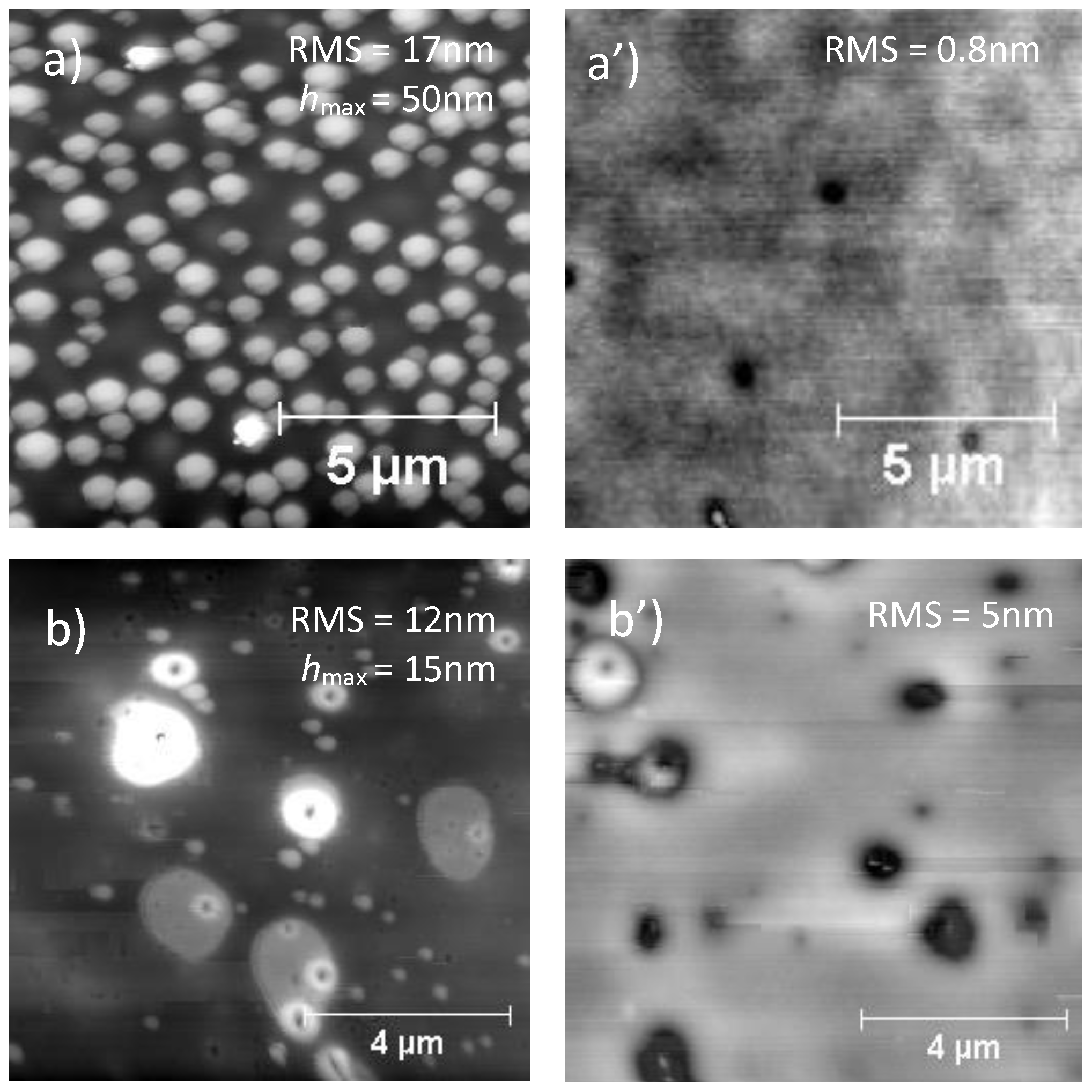
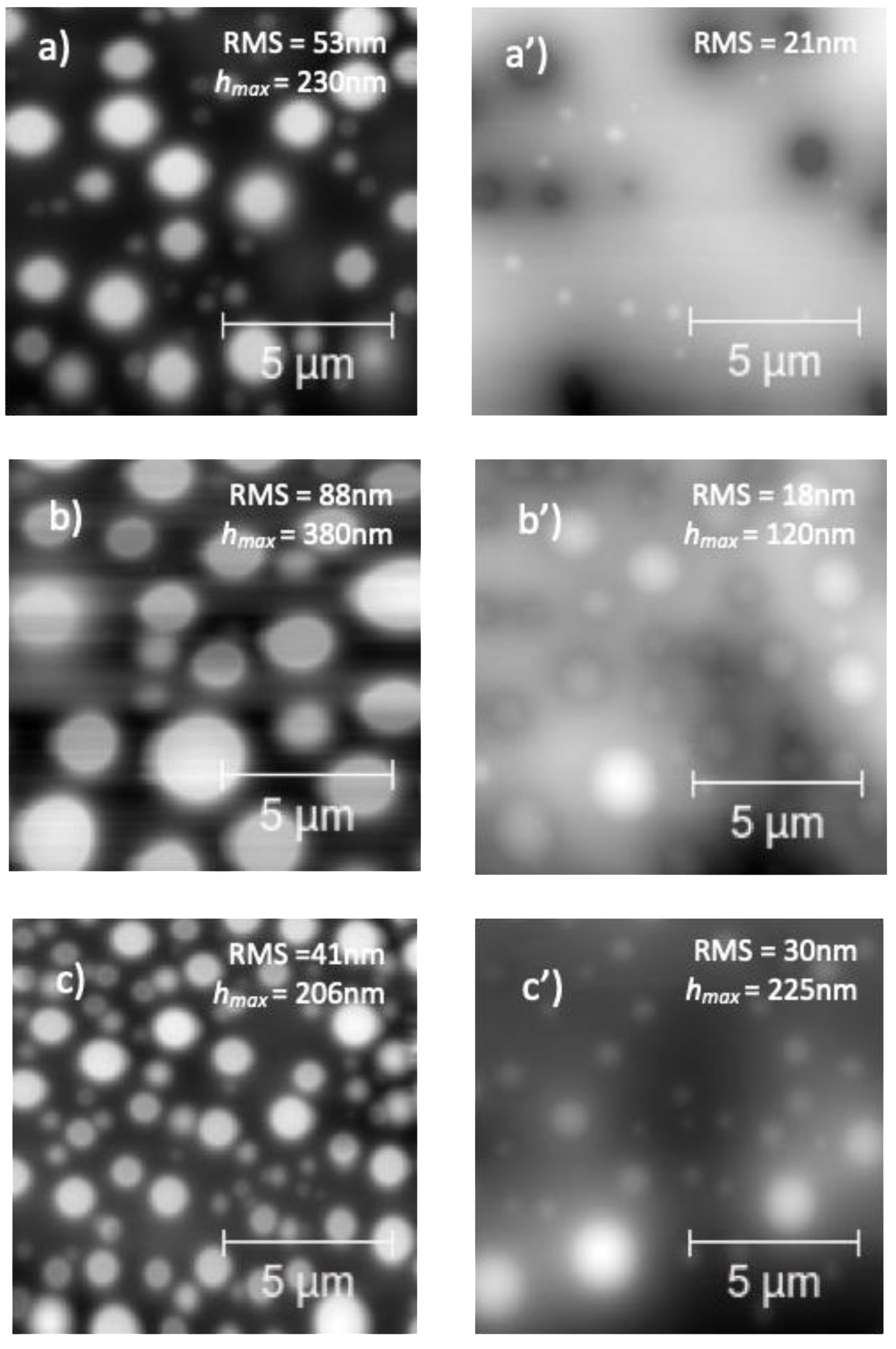

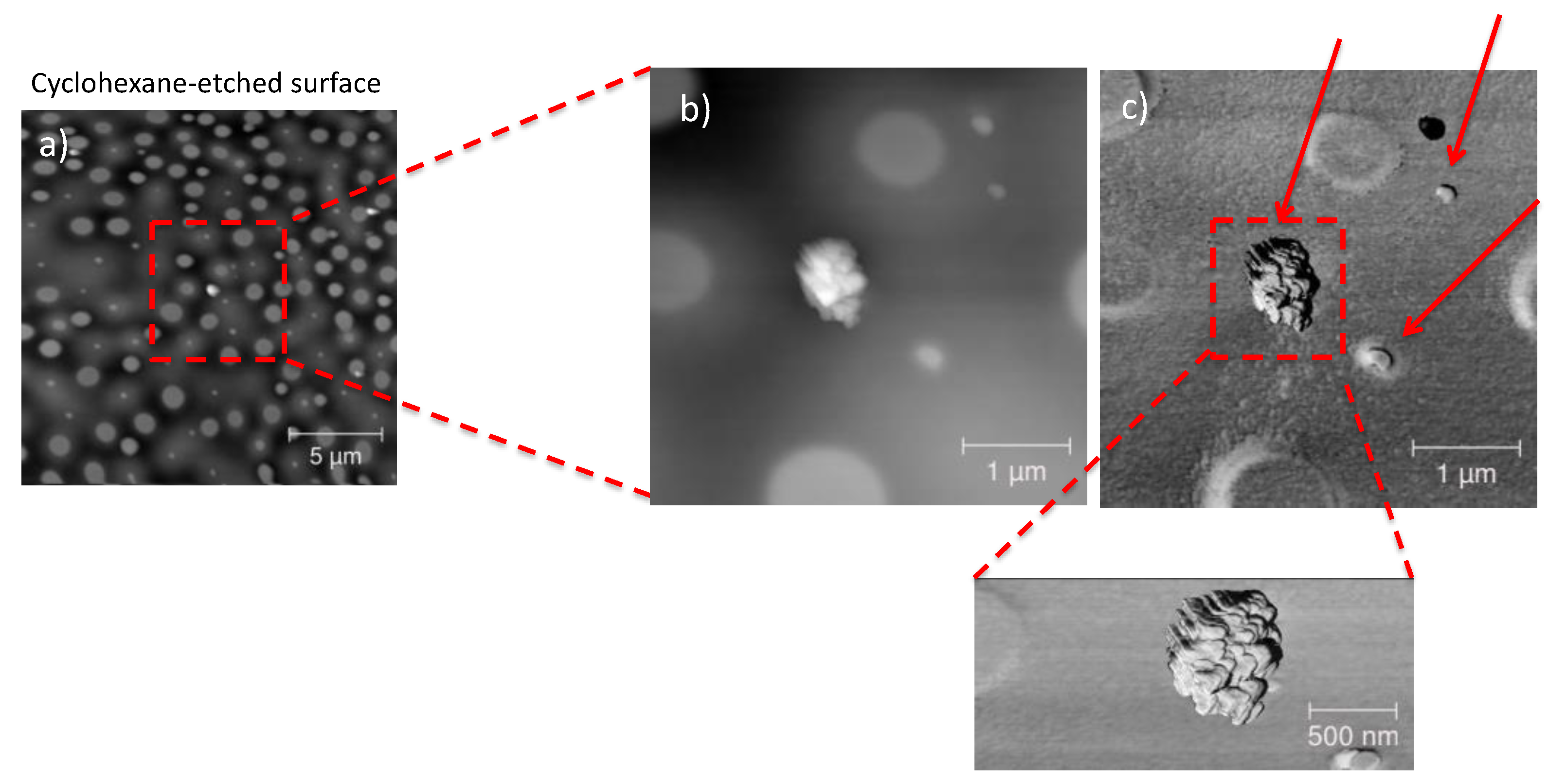
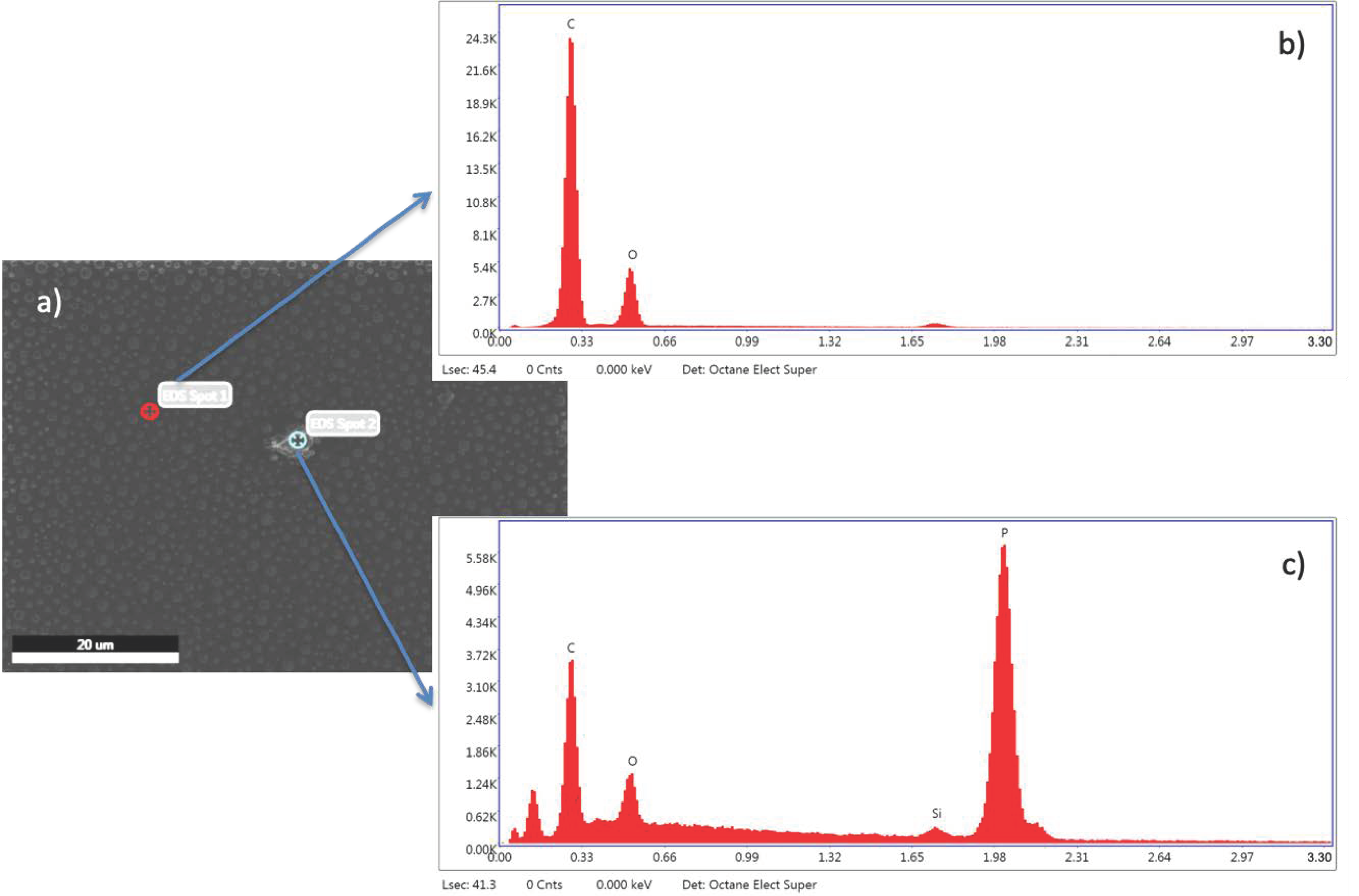
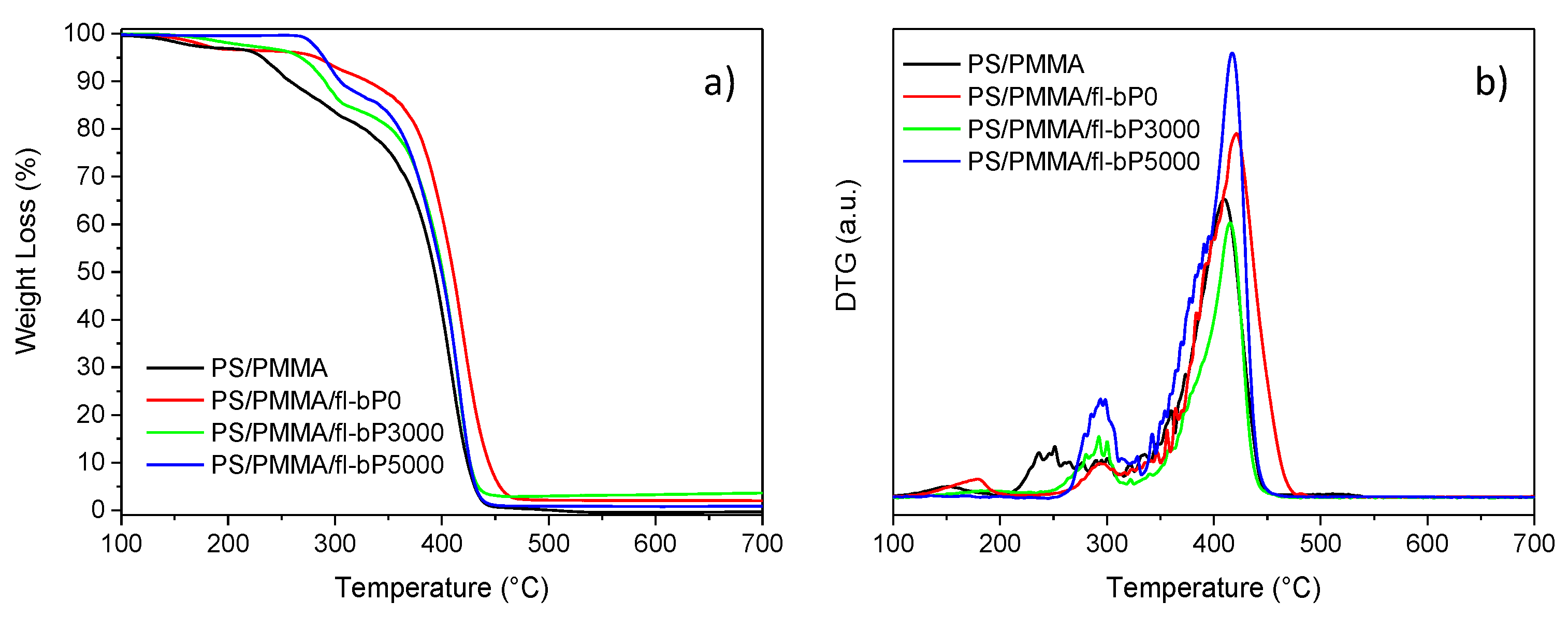
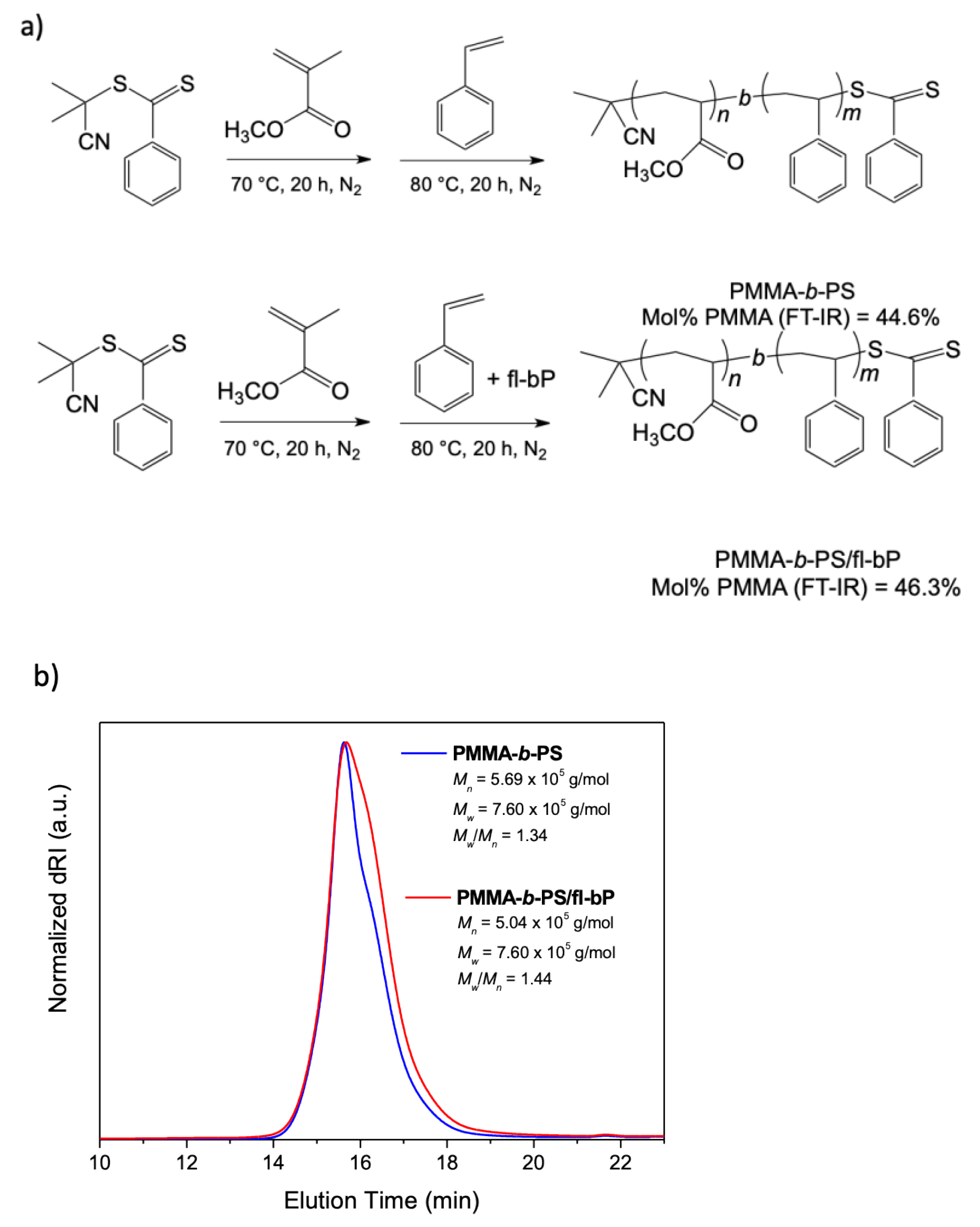



| Sample | Conversion 1 (%) | Mn (g/mol) | Mw/Mn |
|---|---|---|---|
| PMMA-CPDB | 67 | 29,700 | 1.25 |
| PMMA-b-PS | 67 + 34 | 56,900 | 1.34 |
| PMMA-b-PS/fl-bP | 67 + 24 | 50,400 | 1.44 |
| Sample | Tg,PS1 (°C) | Tg,PMMA1 (°C) | Tonset2 (°C) | Tmdr3 (°C) |
|---|---|---|---|---|
| PS | 105.3 | − | 394 | 414 |
| PMMA | − | 122.4 | 261 | 282; 389 |
| PS/PMMA | 103.6 | 119.8 | 223 | 251; 411 |
| PS/PMMA/fl-bP0 | 105.0 | 125.0 | 275 | 294; 422 |
| PS/PMMA/fl-bP3000 | 107.0 | 124.5 | 264 | 292; 415 |
| PS/PMMA/fl-bP5000 | 104.4 | 122.0 | 274 | 295; 417 |
Publisher’s Note: MDPI stays neutral with regard to jurisdictional claims in published maps and institutional affiliations. |
© 2021 by the authors. Licensee MDPI, Basel, Switzerland. This article is an open access article distributed under the terms and conditions of the Creative Commons Attribution (CC BY) license (https://creativecommons.org/licenses/by/4.0/).
Share and Cite
Coiai, S.; Passaglia, E.; Pinna, S.; Legnaioli, S.; Borsacchi, S.; Dinelli, F.; Ferretti, A.M.; Caporali, M.; Serrano-Ruiz, M.; Peruzzini, M.; et al. Dispersion of Few-Layer Black Phosphorus in Binary Polymer Blend and Block Copolymer Matrices. Nanomaterials 2021, 11, 1996. https://doi.org/10.3390/nano11081996
Coiai S, Passaglia E, Pinna S, Legnaioli S, Borsacchi S, Dinelli F, Ferretti AM, Caporali M, Serrano-Ruiz M, Peruzzini M, et al. Dispersion of Few-Layer Black Phosphorus in Binary Polymer Blend and Block Copolymer Matrices. Nanomaterials. 2021; 11(8):1996. https://doi.org/10.3390/nano11081996
Chicago/Turabian StyleCoiai, Serena, Elisa Passaglia, Simone Pinna, Stefano Legnaioli, Silvia Borsacchi, Franco Dinelli, Anna Maria Ferretti, Maria Caporali, Manuel Serrano-Ruiz, Maurizio Peruzzini, and et al. 2021. "Dispersion of Few-Layer Black Phosphorus in Binary Polymer Blend and Block Copolymer Matrices" Nanomaterials 11, no. 8: 1996. https://doi.org/10.3390/nano11081996










